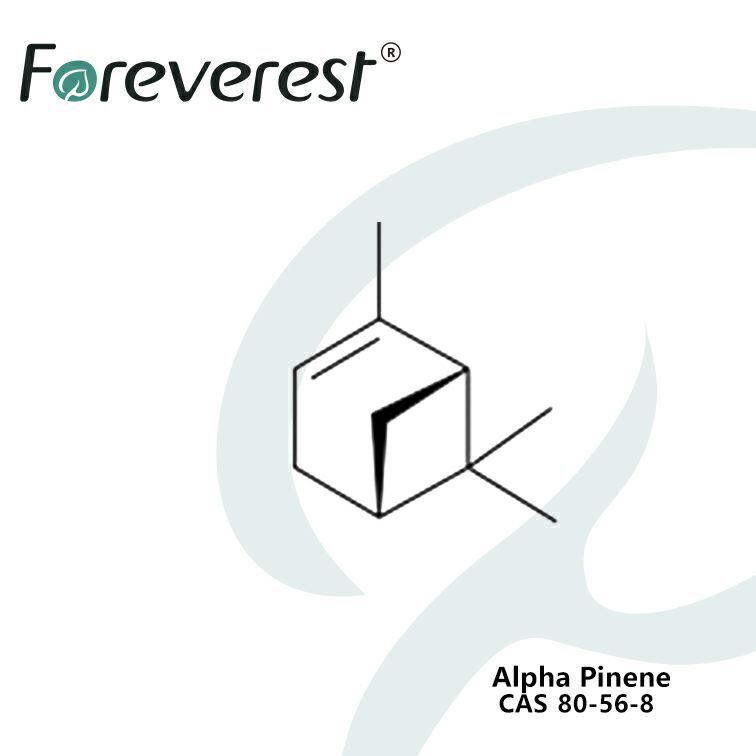alpha-Pinene
alpha-Pinene is an important monoterpene naturally occurring in nature, known for its distinctive pine scent. It is a primary component of Gum turpentine and is widely found in over 400 types of natural essential oils, including those from pine, fir, eucalyptus, rosemary, sage, and frankincense.
Industrially, high-purity alpha-Pinene is primarily extracted through the fractional distillation of gum turpentine, ensuring its quality and stability.
In the flavor and fragrance industry, alpha-Pinene is primarily used to synthesize compounds such as Terpineol, Linalool, and other sandalwood fragrances. It is also used as a flavoring agent in daily chemicals, with a typical content of less than 2%.
Substance Identification
| Synonyms | α-Pinene |
| CAS | 80-56-8 |
| EINECS | 201-291-9 |
| FEMA | 2902 |
| HS.CODE | 290219 |
| Molecular Formula | C10H16 |
| Moleclar Weight | 136.24 |
Toxicological Information
| LD50 oral, rat | 1.9g/kg min |
| LD50 dermal, rabbit | 2.4g/kg min |
Application & Uses
- Key Aroma Chemical Intermediate: alpha-Pinene serves as a crucial starting material in the flavour and fragrance industry, extensively used for the synthesis of various valuable aroma chemicals such as Terpineol, Linalool, Camphor, and for creating sandalwood-type fragrances.
- Direct Application in Flavours & Fragrances: As a unique aromatic component, it is directly incorporated into fragrance formulations to impart fresh, woody, and pine-needle-like notes. In daily chemicals, it is also commonly used as a flavouring or enhancing agent, typically at concentrations of less than 2%.
- Other Industrial Applications: alpha-Pinene also acts as an important chemical intermediate in the synthesis of resins, adhesives, solvents, and within the pharmaceutical sector, for instance, it can be used in the preparation of terpene maleic anhydride (TMA).
Sales Specification
| ITEM | VALUE |
|---|---|
| Appearance | Colorless to pale yellow liquid |
| Odor | Woody |
| Refractive Index, @ n20/D | 1.464~1.474 |
| Relative Density, @ d20/4 | 0.855-0.870 |
| Acid Value, mgKOH/g | ≤0.5 |
| LD50 oral, rat | 1.9g/kg min |
| LD50 dermal, rabbit | 2.4g/kg min |
Similar Specs
GHS Hazard Statements
| H-Code | H226/303/304/315/317/410 |
| P-Code | P210/233/240/241/242/243/261/264/272/273/280 |
| Response | P301+P310 P303+P361+P353 P312 P331 P333+P313 P370+P378 P391 |
| Storage | P403+P235 P405 |
| Disposal | P501 |
Storage
- Environmental & Temperature Control:
- Store within the specified temperature range in a dry, well-ventilated area, and protect from light.
- A refrigerated room would be preferable for materials with a flash point lower than 37.8°C (100°F).
- Keep in a cool, well-ventilated place.
- Container Management & Prevention:
- Ensure containers are tightly closed and clearly labelled.
- Ground all equipment containing material to prevent static build-up.
- Hazard Isolation:
- Keep storage areas away from heat, sparks, open flames, and all sources of ignition.
- Flammable materials should be stored in a separate safety storage cabinet or room.
- Keep away from incompatible materials to prevent hazardous reactions.
- Safe Handling & Inspection:
- Handle carefully, and stack stably.
- After prolonged storage, always check quality before use.
- Compliance & Emergency Preparedness:
- Strictly comply with all safety regulations.
- Ensure emergency plans are in place for unforeseen circumstances.
Relation Products
Relation Articles
Remark
Start Purchasing
-
Minimum Order Quantity
Quote required -
Lead Time
Quote required -
Available Incoterms
Quote required -
Regional Availability
Quote required
